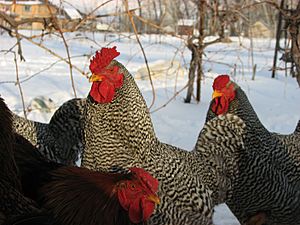Dominique chicken facts for kids

A Dominique cockerel (6 months old, center)
|
|
| Conservation status | Watch |
|---|---|
| Other names |
|
| Country of origin | United States |
| Use | Dual purpose breed |
| Traits | |
| Weight |
|
| Skin color | Yellow |
| Egg color | Brown |
| Comb type | Rose |
| Classification | |
| APA | American |
| ABA | rose comb, clean legged |
| PCGB | rare soft feather: heavy |
|
|
The Dominique chicken is also known as the Dominicker or Pilgrim Fowl. It is a special type of chicken that first appeared in the United States. This happened a long time ago, during the colonial period. Many people think it's America's oldest chicken breed. It likely came from chickens brought to New England from England.
By the 1800s, Dominiques were very popular across the country. They are a "dual purpose" breed. This means they are good for both their meat and their brown eggs. Adult Dominiques usually weigh about 6 to 8 pounds. Long ago, their soft feathers were even used to stuff pillows and mattresses!
Contents
History of the Dominique Chicken
The Dominique chicken was first written about in the Northeast United States. This was around places like Boston, Massachusetts. In the 1870s, a new chicken breed called the Plymouth Rock was created. It was developed from the Dominiques. After this, the Dominique's popularity went down.
By 1950, these chickens were very rare. People thought they might even disappear completely. In the 1970s, the American Livestock Breeds Conservancy listed Dominiques as "Critical." This meant there were fewer than 500 breeding birds in North America. Luckily, people became interested in rare breeds again. Dominiques have made a comeback! They are now on the "Watch" list. This means they are much safer from disappearing.
What Does a Dominique Chicken Look Like?
Dominique chickens have a very unique look. They have a special comb on their head called a "rose comb." Their feathers are thick and have stripes of dark grey and light grey. This pattern is called "barring" or sometimes "hawk coloring." People often mistake this for black and white stripes.
Dominiques grow up quickly. Hens can start laying eggs when they are about six months old. At first glance, Dominiques and Barred Rocks look very similar. It can be hard to tell them apart. The best ways to tell them apart are by looking at their comb, feathers, and color.
Comb Differences
Dominique chickens have a rose comb. Barred Rock chickens have a single comb. This is usually the easiest way to spot the difference.
Feather Patterns
Dominiques have a "staggered" barring pattern on their feathers. This makes them look a bit mottled or mixed up. Barred Rocks have very clear, straight stripes on their feathers.
Color Shades
Dominiques have a softer color contrast. Their stripes are "not quite black on not quite white." Barred Rocks have a strong, clear black-on-white color.
Dominique Behavior and Temperament
Dominique hens are usually calm and friendly birds. This makes them great for laying eggs. Their calm nature also makes them good show birds or family pets. Dominique roosters, however, can be very protective. They are known to be quite aggressive at times.
Dominique hens are also good mothers. They are good at brooding eggs and raising their chicks. They have a high success rate. This breed is very hardy and good at finding its own food. These traits come from the tough conditions where the breed first developed.
Images for kids



